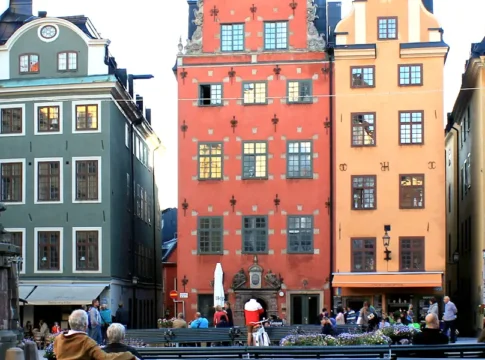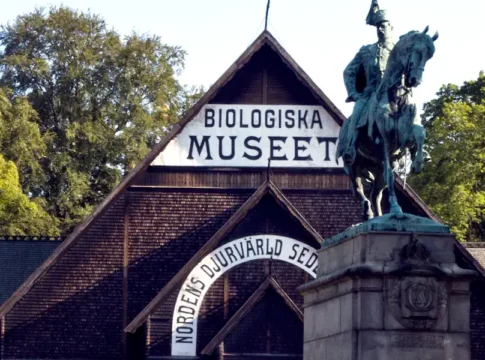Stockholm City Hall: Architectural Splendor
Situated on the eastern tip of Kungsholmen Island, Stockholm City Hall (Stockholms stadshus) stands as one of Sweden’s most iconic landmarks and a masterpiece of National Romantic architecture. Designed by renowned architect Ragnar Östberg, the building was constructed between 1911 and 1923, blending traditional Swedish design with Venetian and Renaissance influences.


Architectural Highlights
Stockholm City Hall is a striking mix of styles and symbols. Highlights include:
- 🏰 National Romantic Style: Built with Swedish materials and motifs, celebrating national pride and continuity.
- 🎭 Venetian Influences: The colonnade and inner courtyard recall Renaissance palaces, especially Venice’s Doge’s Palace.
- 🗼 Iconic Tower: The 106-meter tower, crowned with Sweden’s three golden crowns, offers panoramic views over the city.




Main Attractions Inside Stockholm City Hall
Step inside and discover richly decorated spaces full of symbolism:
- 🎼 Blue Hall: Known for hosting the Nobel Banquet, this red-brick hall contains Scandinavia’s largest organ with 10,000 pipes.
- 👑 Golden Hall: Glittering with 18 million gold mosaic tiles, it depicts scenes from Swedish history and mythology.
- 📸 The Tower: Climb for sweeping views of Stockholm and its archipelago.
- 🌇 Prince’s Gallery: A gallery with dramatic views of the city and Lake Mälaren.
- 🏛️ Council Chamber: The City Council’s meeting hall, with a ceiling inspired by an inverted Viking ship.




Venue for the Nobel Prize: A Celebration of Excellence
Every December 10th, the Nobel Banquet is held in the Blue Hall, honoring Nobel Laureates. After the banquet, guests move to the Golden Hall for dancing. Attended by the Swedish Royal Family, international dignitaries, and celebrated scholars, it remains one of Sweden’s most prestigious events.
Construction and Materials
- Materials: Built with over 8 million red bricks and 19 million tiles sourced from Swedish suppliers.
- Foundation: Set firmly on bedrock to ensure stability.
- Design Elements: Decorated with national motifs, including references to the old royal castle Tre Kronor, with granite and marble from Sweden.






ℹ️ Visitor Information
- 🕰️ Opening Hours: Guided tours are offered daily; check the official website for current times.
- 📍 Address: Hantverkargatan 1, Kungsholmen, Stockholm
- 🚶♀️ Getting There: Accessible by metro; the nearest station is Rådhuset (Blue Line).
- 🔍 What to Expect:Explore the grand halls and historic chambers of Stockholm City Hall. The tower offers stunning panoramic views, but please note that it’s only open during selected periods.
- 🎟️ Admission: Entry is by guided tour only; tickets available on-site or online.
- ☕ Café: A café on-site offers refreshments and light meals.
🧭 What’s Nearby?
Enhance your visit by exploring these nearby attractions:
- 🏘️ Gamla Stan — Stockholm’s medieval Old Town, filled with cobblestone streets, historic landmarks, and lively cafés.
- 👑 The Royal Palace — One of Europe’s largest palaces, featuring royal apartments, museums, and the daily guard ceremony.
- ⚰️ Riddarholmen Church — Burial site of Swedish monarchs and one of Stockholm’s oldest preserved buildings.
- 🚶♂️ Klara Sjö Promenade — A scenic waterfront walk along Kungsholmen’s canal, perfect for a relaxing stroll.
[amazon_ads store=”sthlmmm-20″ asin1=”B0BN6HZ4JG” img1=”https://m.media-amazon.com/images/I/61IX47b4r9L
.SL1449.jpg” title1=”Stadshuset; en vägvisare, av Ragnar Östberg” asin2=”9187007029″ img2=”https://m.media-amazon.com/images/I/A15IaBBq51L
.SL1500.jpg” title2=”Secrets of the Walls: A Guide to Stockholm City Hall” asin3=”B00G3QCQTS” img3=”https://m.media-amazon.com/images/I/61UKTqvP55L
.AC_SL1008.jpg” title3=”Stockholm and City Hall – Vintage Travel Poster by Iwar Donner c.1936″]





